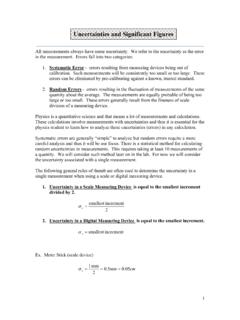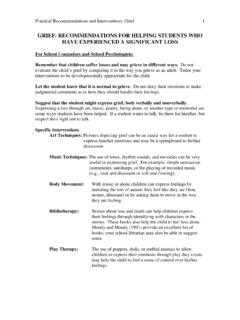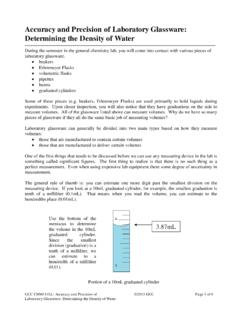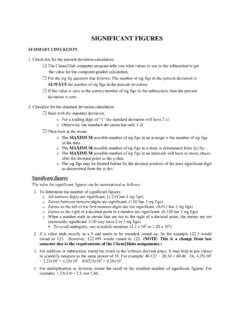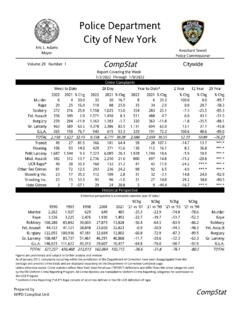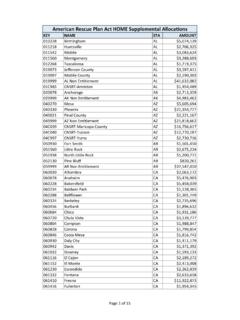Transcription of Facts & Figures About Canadian Field Crop Farming in Canada
1 Major Field crops grown in Canada include wheat, canola, barley, cornand soybeans. Other crops include rye, oats, white beans and mixedgrains. Several specialty crops, which are limited to a very small areaof land, are also grown in certain regions. Crops grown varydepending on the specific growing abilities of each region and onthe farmers farmers grow crops specifically to sell them. These farmers arecalled cash crop farmers. Many livestock farmers grow crops aswell. These crops can then be harvested and used to feed the animalson the farm. If production is higher than what the farm requires, excesscrops will be marketed and :You were asking Crop FarmingIn General: The crop grown with the largest acreage in Canada is wheat,followed by canola.
2 Corn and wheat are widely grown across the country. Soybeansare found mostly in Ontario, Quebec and Manitoba while canolais grown principally in Western Canada . In Ontario corn is the most common Field crop, while in the western provinces, wheat is the most common. Canada s malt barley is top quality, making Canada the second largest exporter of malt world-wide. Grain and oilseeds can be found in products we use every day around the home and office. Sugar beets are grown in specific areas of Ontario and Alberta. There is only one sugar beet processor in Canada ,found in Alberta. Canada is the world s largest exporter of pulses (beans, peas, chickpeas and lentils).
3 Pulse crops containnutrients found in both the vegetable and meat food groups, including significant protein, fiber, folate, iron andother minerals. GPS technology is used on farms to track nutrient levels and yields in different parts of a Field , helping farmersfertilize more accurately and reducing the risk of fertilizer CropFacts & Figures About CanadianField Crop Farming in CanadaEach crop requires a different set of nutrients from the soil, so farmersdevelop a crop rotation which allows them to maximize nutrient usefrom and return to the soil. Crop rotation also benefits the soil in anumber of other ways.
4 Changing the type of roots in the soil each yearwill benefit soil structure. Fertilizer use can also be reduced as cropswill add nutrients back to the soil which crops in a subsequent yearcan use. Certain insects and diseases which target Field crops canlive in the soil over the winter. Since many insects and diseases targetspecific crops, rotating the crops allows for a natural method ofprotecting against pests, therefore reducing the amount of Rotation:Tillage SystemsIn the past, farmers would till (turn up) the soil with several different machines betweencrops. Tillage is done to incorporate crop stubble into the soil as a form of fertilizer andreduce the amount of weeds farmers are using more conservation tillage or no-tillage systems than theirancestors did.
5 In conservation tillage, the soil is still tilled, but not as much as it wouldhave been in the past. The crop stubble will not be incorporated into the soil as completelyas it would be in a more intensive tillage system. Modern tillage equipment does the job ofseveral different old pieces of equipment, limiting the number of passes a farmer has tomake on the Field . This reduces fuel consumption, emissions, and soil systems do not till the soil at all between crops. Stubble is not disturbed betweenharvesting one crop and planting the next. In no-till systems, crop rotation is necessary forassisting with pest control and improving soil SeasonsMost crops, but not all, are planted during the spring and harvested during the fall.
6 Wheat can beplanted in either spring or fall, and is harvested during the summer. Hay fields are harvestedmultiple times each year, and grow hay for three to four years at a time. Spring planting is startedduring late April or early May in most years, once the threat of frost is Crop Dictionary Hectare (ha): A hectare is 100 metres x 100metres. It is equal to acres. A hectare isabout the size of two soccer fields. Acre An acre is slightly smaller than asoccer Field . Integrated Pest Management (IPM) Asystem of managing pests (weeds, insects,disease, fungus, nematodes, rodents) thatinvolves more than one control method mechanical ( tillage) cultural ( usingcertified seed), biological ( use of a pest snatural enemies), or chemical ( pesticides) in a program that is both economically andenvironmentally sound.
7 Soil type The texture of the soil based onthe percentage of sand, silt, and clay. Hybrid Plants produced by crossing two ormore inbred lines of plants that aregenetically quite different. Tillage Cultivating the soil to prepare forplanting or to reduce weeds. Reduced, Conservation or No-tillfarming Reducing or eliminating tillage inorder to minimize soil disturbance andmaintain as much crop residue cover aspossible. This leads to better protection of soilfrom wind or water erosion, less fuelconsumption, and better carbonsequestration. Crop Rotation The practice of plantingdifferent crops on a Field year after year tominimize pest population build up, improvesoil health, avoid pesticide resistance issues,and diversify ( a common rotation inOntario is soybeans, wheat, and corn repeatedevery three years or with hay included forlivestock farms).
8 Did You Field crops can be found in a wide variety of everyday household products,including car parts, cosmetics, dyes, clothing and more. At the 2009 Royal Agricultural Winter Fair, an entire house was built andfurnished using products made from soybeans. If you ate a sandwich for breakfast, lunch and dinner, it would take 168 daysfor one person to eat the bread produced by one bushel of wheat. Corn is an ingredient in more than 3,000 grocery products. 100 acres of soybeans can produce enough soy beverages for half a millionpeople. Hay is essentially dried grass. The kind of grass grown depends on thefarmer and what kind of animal the hay will be fed to.
9 Pot barley has the bran and germ intact, making it a whole grain. Pearlbarley has been steam processed to remove the bran. Oatmeal goat s milk soap can help soothe and moisturize extremely dryskin, and has even been used by eczema sufferers. Canola was in large part invented by Agriculture and Agri-FoodCanada scientists and is now the oil of choice for millions around theworld because of its nutritional attributes. Durham wheat, used for pasta, is grown in western Canada . Otherwheat varieties, used for flour, are grown across CropAfter the HarvestOnce grain and oilseed crops are harvested, they are either stored on the farm in largegrain bins or sent to a grain elevator or feed mill for storage or sale.
10 Grain elevators buycrops from a large number of farmers to resell to large customers such as feed mills orprocessing can be harvested wet or dry. Harvested wet, it is placed in silos to ferment and becomehaylage. Harvested dry, it is baled and stored in barns or sheds for future use. Hay is eatenby ruminants, such as cattle, sheep, goats and deer, but also by rabbits and by: About Field Crops Additional Website LinksCanada Grains CouncilVisit Growers of CanadaVisit Wheat BoardVisit Farmers of OntarioVisit Bean GrowersVisit Seed Growers AssociationVisit Canola Growers AssociationVisit Canola Producers CommissionVisit Canola Growers AssociationVisit Sugar Beet GrowersVisit PotatoesVisit Potato BoardVisit an Ontario crop farm on line at & Food Care What About Biodiesel and EthanolBiodiesel is a clean-burning alternative fuel produced from renewableresources, like animal fats and plant oils.
